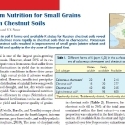16 Jan 2012
Optimization Principles of Nitrogen Management for Winter Wheat at the Farm Level
V. A. Romanenkov
The geographic network of experiments with fertilizers created in Russia on the initiative of D.N. Pryanishnikov represents an adequate tool to solve such problems as optimization of N rates for winter wheat. Officially, these experiments began in 1941. The results obtained up to 1970 made it possible to find the major regularities concerning zonal effects of different kinds and rates of fertilizers. The efficiency of average rates of fertilization was also determined. On this basis, the efficiency of fertilizer use on the main types of soils was calculated, and recommendations on the optimum average rates of fertilizers in the main soil-climatic zones and economic regions of the country were suggested (Regulations for Determining the Demands of Agriculture in Mineral Fertilizers, 1985).
However, these rates had to be specified for the particular farms and fields. The corrections were made for the degree of soil cultivation, for the planned crop yields, and for the particular cultivation technologies (Litvak, 1990). The calculation methods used to find optimum fertilizer rates had their own drawbacks related to difficulties in the transformation of the growing amount of factual data into relatively simple calculation schemes and in the refinement of the latter. The dynamics of prices for agricultural produce and fertilizers and the variation in weather conditions represented major difficulties for the researchers. The study of such multifactor systems remains a quite complicated problem despite the long-term experience in this field and the diversity of the methods used to calculate the rates of major nutrients and ratios between them.
The mean yield of winter wheat in the Moscow region in 2005–2009 reached 2.78 t/ha. This is sufficient for the profitable production of wheat grains, particularly with the predicted favorable changes in the climate of the nonchernozemic zone in the 21st century (Gordeev et al., 2006).
Calculation of the Rates of Nitrogen Fertilizers Ensuring Their Payback
The experiments performed during 32 years at the Central Experimental Station of the Pryanishnikov All-Russia Research Institute of Agricultural Chemistry (VNIIA) in Domodedovo district of Moscow oblast provided 380 results of regular observations of the efficiency of fertilizers with variations in the rates of N (0 to 240 kg/ha), P2O5 (0 to 180 kg/ha), and K2O (0 to 260 kg/ha). The agrochemical indices of the soil fertility varied within the following limits: organic matter content, 1.1 to 1.9%; soil pH, 4.1 to 6.6; available P2O5, 11 to 166 mg/kg; and available K2O, 79 to 318 mg/kg. According to the norms of fertilizer payback, the recommended rates of application of N, P2O5, and K2O were 100, 90, and 90 kg/ha, respectively. The efficiency of fertilizers depended on the water supply conditions and varied within 40 to 70% of the value obtained at the control plot.
These data showed that in the case of the low supply of available P, the efficiency of average rates of N fertilizers (60to 90 kg/ha) is subjected to considerable fluctuations depending on weather conditions. In the case of the medium supply of available P, the highest gains in the yield of winter wheat were obtained with application of N at the rate of 60 to 90 kg/ha. Under favorable weather conditions, the gain in grain yield reaches 2.4 t/ha. With higher rates of N fertilizers, it decreases. This decrease was especially pronounced for N fertilization rates of 120 to 150 kg/ha. In the case of the low nutrient status of the soil, the maximum gain in the yield was achieved with N fertilization rates of 120 to 150 kg/ha, though the absolute increase was less than 1.2 t/ha (Romanenkov et al., 2008).
Regression models have been used to calculate the yields, fertilizer payback, and net revenue (Sirotenko et al., 2009). To calculate the revenue, a standard index – bulk profit from grain sales minus the cost of N fertilizers – was used. Real net revenue, of course, is lower (Buresh and Witt, 2008), resulting in lower net revenue. However, this index proved to be helpful for comparing the economic efficiency of the suggested fertilizer management practices. Two extreme scenarios reflecting the maximum and minimum ratios of grain prices and N fertilizer costs were examined on the basis of real values in 2006–2009. As suggested by Buresh and Witt (2008), the cost of fertilization and harvest operations have not been taken into account.
Calculations for Average Weather Conditions with Changing Grain Price/Fertilizer N Cost Ratios
The results of calculations are shown in Table 1 and Figure 1. As seen from Table 1, the optimum rates of N fertilizers in the case of the minimum grain price/fertilizer N cost ratio and maximum profit range from 80 to 100 kg/ha. In this case, the grain yield reaches 2.8 t/ha on the highly fertile soils and 2.1 t/ha on the low fertility soils. The return does not exceed 10 kg grain/kg N fertilizer. The rate of N fertilizer application can be reduced by 10 kg/ha in the case of highly fertile soils. The use of new wheat strains against the background of wellmanaged fertile soils makes it possible to raise the return to 15 kg/kg with the increased rate of N fertilizer application (100 kg/ha). In this case, the yield reaches 3.2 t/ha (or 57% of the maximum yield). The gross return increases by USD 80/ha due to improvement of soil fertility and by an additional USD 30/ha with the use of new wheat varieties. In the latter case, it is possible to increase the return by 1.5 times (up to 15 kg/ha).
With the maximum grain price/fertilizer N cost ratio, which is much more favorable for farmers, the optimum rate of N fertilizer increases to 140 kg/ha. In this case, the return gained from the highly fertile soils increases from 8 to 13 kg/ha, and the grain yield increased up to 3.1 t/ha, approaching the maximum value.
The use of new varieties makes it possible to reduce the optimum rate of fertilizer N and to raise the return to 14 kg/kg. In this case, the gain in yield is relatively low (from 3.1 to 3.2 t/ha). The economic efficiency of measures on the improvement of soil fertility reaches about USD 110/ha; the use of new varieties increases it by about USD 40/ha.
As follows from this analysis, with the high cost of fertilizer N and low grain price, the average (for the entire Moscow oblast) grain yield can only be achieved upon winter wheat cultivation on the highly fertile soils. The improvement of soil fertility does not lead to the corresponding rise in the gross return over fertilizer cost, and the additional gain in the yield and return rates (by 15 and 50%, respectively) can be achieved with the use of new wheat varieties. Thus, the recommended rate of fertilizer N is 100 kg/ha, which corresponds to the average rate of N fertilization in Moscow oblast. In other cases, the maximum return can be gained with the lower (by 10 to 20 kg/ha) rates of fertilizer N application.
With the more profitable grain price/fertilizer cost ratio, the optimum rate of fertilizer N can be increased up to 140 kg/ha. The improvement of soil fertility ensures the gain in the gross return by USD 30/ha in comparison with the previous scenario, and the use of new wheat varieties makes it possible to reduce the rate of fertilizer N to 110 kg/ha for the same economic efficiency of farming as in the case of the unfavorable grain price/fertilizer cost ratio.
Calculations Considering Weather Conditions and Changing Grain Price/Fertilizer N Cost Ratios
Proper accounting for real weather conditions makes it possible to introduce certain corrections to the optimum rates of fertilizers. With the favorable grain price/fertilizer cost ratio and favorable weather conditions, the optimum rate of fertilizer N can be increased by 70 kg/ha (up to 210 kg/ha). This assures a grain yield of 4.9 t/ha and a return of 10 kg grain/kg fertilizer N and the gross revenue increases by 56%, or by USD 145/ha in comparison with the average revenue for the soils with the high fertility level (Table 1, Figure 2).
With an unfavorable grain price/fertilizer N cost ratio, the optimum rate of fertilizer N can also be increased by 70 kg/ha, or up to 150 kg/ha, which should provide a return of 13 kg/kg and a yield of 4.6 t/ha (or 90% of the maximum yield). The additional gross revenue increases by two times (double) in comparison with the average revenue for the soils with the high fertility level and reaches USD 81/ha.
Under unfavorable weather conditions and favorable grain price/fertilizer cost ratio, the optimum rate of fertilizer N decreases from 140 to 100 kg/ha, providing a grain yield of 2.27 t/ha on the highly fertile soil and 1.55 t/ha on the low-fertility soil with the return of 6 kg/kg. The loss in the gross revenue in comparison with that in the year with average weather conditions is estimated at USD 115/ha, which is comparable with the effect of soil improvement procedures (Table 1).
Under the same weather conditions and unfavorable grain price/fertilizer cost ratio, the optimum rate of fertilizer N should be decreased to 40 kg/ha with grain yields on the highly fertile and low-fertile soils of 1.97 and 1.25 t/ha, respectively. The return from fertilizer N application reaches 9 kg grain/kg fertilizer, and the loss in the gross revenue (in comparison with the year with average climatic conditions) is estimatedat USD 67/ha. It should be noted that a decrease in the grain yield corresponding to the maximum return on the low-fertility soils in comparison with that on the highly fertile soils with the unfavorable grain price/fertilizer cost ratio reaches 58%. When the grain price/fertilizer cost ratio is favorable, it decreases by 46%. In comparison with the minimum average yield in Moscow oblast for 1995–2009 (1.42 t/ha for the low-fertile soils), the yield gained on the experimental field during the year with unfavorable weather conditions even in the case of the optimum rate of fertilizer N is somewhat lower. The surplus yield (in comparison with the average yield in Moscow oblast) in the year with unfavorable weather conditions with both favorable and unfavorable grain price/fertilizer cost ratios can only be gained on the highly fertile soils.
As seen from this example, the grain price/fertilizer cost ratio on the market affects the optimum rate of fertilizer N, which should also be corrected for the particular weather conditions. Only in this case, we can avoid application of excessive and economically inefficient fertilizers. With the rise in the grain price/fertilizer cost ratio, increased rates of fertilizer N should be applied in the case of favorable weather conditions. Lowering of the grain price/fertilizer cost ratio necessitates a considerable reduction (by two times) in the rate of fertilizer N application ensuring the maximum gross revenue. This means the relative changes in the yield of winter wheat are highly sensitive to changes in the weather conditions, though the absolute changes in the gross revenue are lowered by $30 to 50/ha.
What are the particular mechanisms for the correction of the optimum rates of fertilizer N application?
The optimum rate of fertilizer N can be calculated with due account for several factors specifying the efficiency of applied fertilizers, depending on precipitation in the spring season, when vegetative growth of winter wheat resumes. Calculations on the basis of the obtained regression equations show that the maximum gain in the yield per unit fertilizer N is proportional to precipitation in April, which specifies soil moisture conditions after the beginning of wheat vegetative growth. For the studied experimental farm, each 10 mm increase in precipitation in April leads to a rise in the fertilizer return rate of 0.6 to 1.5 kg grain/kg N due to the increased grain yield (Figure 3). Thus, if we know moisture conditions for the spring period, we can introduce necessary corrections to the optimum rates of N fertilization during the early stages of the winter wheatvegetation.
Conclusions
The suggested approach specifies the development of grain crop yields at the farm level and makes it possible to predict the efficiency of mineral fertilizers with due account for the particular weather conditions and the level of soil fertility. The optimum rate of fertilizer N increases up to 150 to 210 kg/ha in years with favorable weather conditions. Annual corrections for the level of soil fertility should be determined.
With the high cost of fertilizers and low grain price, the soils of the investigated farm can provide the grain yield equal to the average in Moscow oblast only in the case of the winter wheat growing on the highly fertile soils. With the favorablegrain price/fertilizer cost ratio and unfavorable weather conditions, yields higher than the average yield in the Moscow oblast can also be obtained only on the highly fertile soils. The use of new wheat strains makes it possible to reduce the rates of fertilizer N upon the favorable grain price/fertilizer cost ratio and to gain maximum gross revenue.
Acknowledgment
This study was supported by the Russian Foundation for Basic Research, project no. 07-05-13600. The author acknowledges cooperation and input during preparation of this article from Dr. S. Ivanova, IPNI Vice President, Eastern Europe/Central Asia and Middle East Group, and Director, Central Russia Region.
References
Buresh R.J. and C. Witt. 2008. Better Crops, Vol. 92 (1), 18–22.
Gordeev, A.V., A.D. Kleschenko, B.A. Chernyakov, and O.D. Siretenko. 2006. Bioclimatic Potential of Russia: Theory and Practice, All-Russia Research Inst. of Agricultural Meteorology. KMK Press, Moscow. 512 pp.
Litvak, Sh.I. 1990. Systems Approach to Agrochemical Studies. Agropromizdat, Moscow. 220 pp.
Regulations for Determining the Demands of Agriculture in Mineral Fertilizers. 1985. KMU TsINAO, Moscow. 237 pp.
Romanenkov, V.A., M.P. Listova, M.V. Belichenko, and O.V. Rukhovich. 2009. Plodorodie, Vol. 46 (15), 14–17.
Sirotenko, O.D., V.A. Romanenkov, V.N. Pavlova, and M.P. Listova. 2008. Agrokhimiya, No. 7, 26-33.
Скачать материалы:
Optimization Principles of Nitrogen Management for Winter Wheat at the Farm LevelSize: ,43 MB




